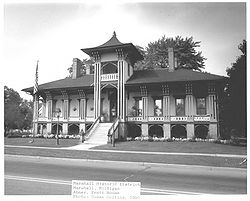Crosswhite Fugitive Slave Case Historical Marker
E. Michigan Ave and E. Mansion St
Adam Crosswhite (1799-1878) and his family had come to Marshall four years before Sheriff Dixon and four armed Kentuckians, including Francis Troutman and David Giltner, came to return them to slavery on January 17, 1847. The five men broke into the Crosswhite house and attempted to kidnap Adam and his family to bring them back to Kentucky and slavery. Adam convinced the Sheriff to allow them to be taken before a judge so that he might hear their case.
While a crowd of 100-200 Marshall citizens gathered, Crosswhite obtained a warrant for the trespassing upon his property and his neighbor, Calvin Hackle, obtained a warrant against Troutman, who had threatened him with a gun. Troutman and his associates were forced to leave the Crosswhite house for the trial, which resulted in a fine of $100 against the Kentuckians. While the court proceedings were ongoing, the Crosswhite family escaped to Buxton, Ontario, Canada via the Detroit railroad.
The following summer, Francis Giltner, Adam Crosswhite's legal owner, filed a suit against several of the individuals who made up the crowd at the Crosswhites' house that day, including Charles T. Gorham, Jarvis Hurd and Oliver C. Comstock, Jr.. Giltner was hoping to recover damages for sending his agents there to recover Adam and his family. The case was tried for the first time in June of 1848. The jury was unable to agree on a verdict.
The second trial was held in November 1848, and the verdict was rendered for Giltner, assessing his damages at $1926. Together with court costs, the amount owed by Gorham, Hurd and Comstock came to nearly $6000 --- an amount they couldn't reach with their own resources. The decision was based upon the Fugitive Slave Act of 1793. The following month, the citizens of Marshall met and adopted a resolution to appoint a Committee of Correspondence to raise funds for the court costs and damages.
In response to the trial against Charles T. Gorham and others, George DeBaptiste, William Lambert, Henry Bibb, Benjamin F. Dade, Alfred Derrick, Richard Gordon, M.J. Lightfoot and James Maten issued another set of resolutions to the North Star, on December 29, 1848. One of the four resolutions is as follows:
Resolved, That we will never voluntarily separate ourselves from the slave population in the country, for they are our fathers and mothers, and sisters and our brothers, their interest is our interest, their wrongs and their sufferings are ours, the injuries inflicted on them are alike inflicted on us; therefore it is our duty to aid and assist them in their attempts to regain their liberty ("Detroit").

Dr. Oliver C. Comstock, Jr. (1806-1895) came to the Marshall area in 1835. He built this Gothic Revival house sometime between 1849-1856. He served as the state's third superintendent of Public Instruction (1843-1845), superintendent of the construction for the Michigan Central Railroad between Jackson and Kalamazoo, and founder and second president of the Michigan Pioneer and Historical Society. Comstock is perhaps best known as one of the abolitionists involved in the Crosswhite Case. In 1847, he and several other prominent Marshall citizens were convicted and fined for the conspiracy to harbor the fugitive slave family of Adam Crosswhite.
This Michigan Historical Marker was erected in 1980: Oliver C. Comstock, Jr. (1806-1895) built this Gothic Revival house between 1849 and 1856. Comstock, born in Fairfield, New York, migrated to the Marshall area in 1836. He left a well-established medical practice in Trumansburg, New York, to start anew on the Michigan frontier. Later that year, he erected the first brick business building in Calhoun County on Exchange Street. It housed his pharmacy and office.
Opposite side: Oliver C. Comstock, Jr., served as the state's third superintendent of public instruction (1843-45). In 1847 he was one of the abolitionists who prevented Kentucky slaveholders' taking the fugitive slave family of Adam Crosswhite. In 1848 he and several prominent Marshall citizens were convicted and fined for conspiracy to harbor the fugitives. Comstock was superintendent of the construction of the Michigan Central Railroad between Jackson and Kalamazoo and a founder of the Michigan Pioneer and Historical Society.